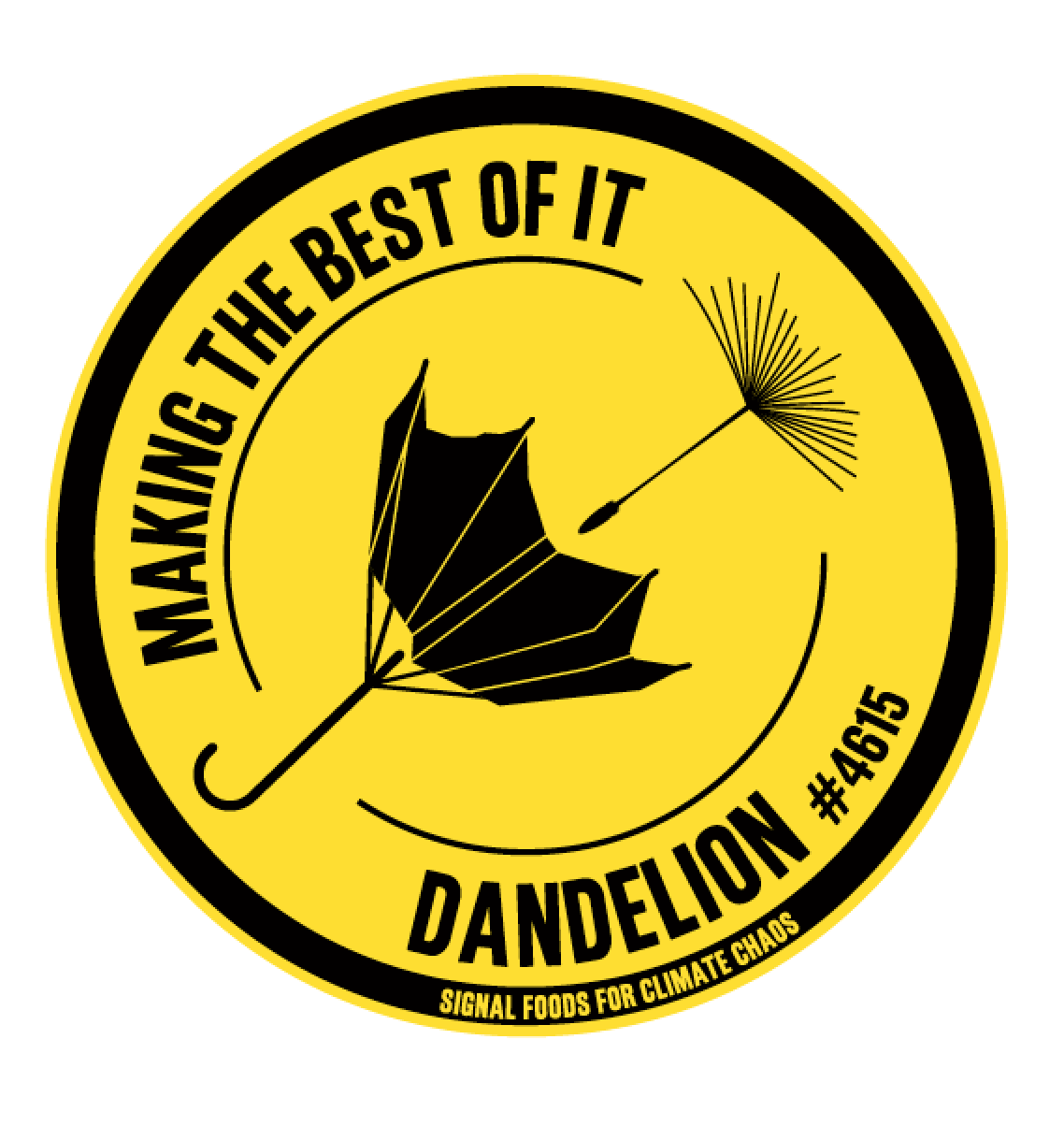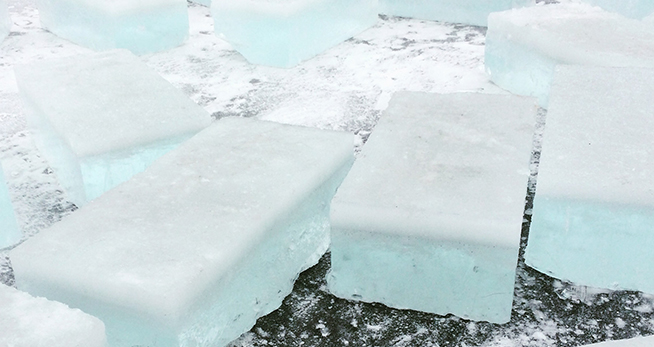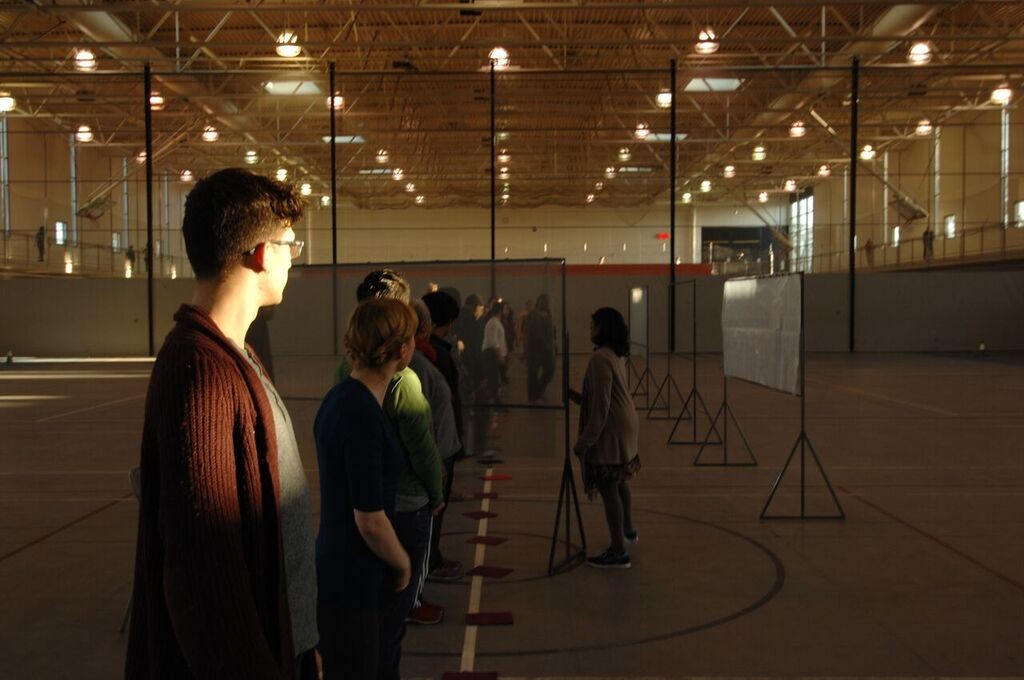
Eating with Strangers to Save the Earth
Essay by Nathan RP Young
With Northern Spark 2016 and 2017 as bookends, Making the Best of It: Dandelion (MtBoI:D) is a 12-month experiment in hospitality and companionship. Through a series of pop-up community meals hosted throughout different neighborhoods across Minnesota, collaborators Marina Zurkow, Valentine Cadieux, Aaron Marx, and Sarah Petersen will sustain conversations about “the risks of climate chaos, our business-as-usual food system, and the short-term food innovations at our disposal.”
MtBoI:D envisions the future through upbeat attitudes inflected with hints of survivalism. As with Zurkow’s tandem iteration of the project, which focuses on jellyfish, the sourcing of meals from both dwindling or abundant anthropocene “wildlife” addresses human-led catastrophes while actually brainstorming opportunities for growth and adaptation.
As climate activist and Northern Spark Advisory Committee member Wen Stephenson points out, “despite the remarkable gains of renewable energy worldwide, and the promise of new technologies, we are nevertheless racing toward worst-case scenarios.” We can either remain paralyzed with indecision or actively make the best of it. Under shadows of bulk data that describe trees suffocating, oil spilling, and refugees fleeing war or climate disasters, MtBoI:D embeds these facts within sustained empathic experiences.
For Cadieux, the 12-month scope of MtBoI:D “allows people to sit with their discomfort” by offering enough time to share and understand one another’s concerns. Because responses to climate change can no longer remain entangled with our own small consumer choices, our next steps must be communal. Upgrading lightbulbs, flushing less, recycling more, even retweeting propaganda, these are helpful but minor. Organizing boycotts, sit-ins, and strikes, coordinating purchasing power en mass and good old fashioned lobbying, these impact progress. And to get there, we can start by sharing meals with strangers and continuing the kinds of difficult conversations that don’t conclude.
At the center of the project’s communal table sits the dandelion, a nutritious and abundant wildflower that can be steeped for tea, fermented for wine, sautéed, eaten raw, pickled, or battered and fried—some research even shows that three cups of dandelion tea can curb the spread of cancer. Not only have dandelions long since proven an endurance in disturbed or anthropogenic habitats like mowed lawns and cracked concrete, in 2007 NPR reported that scientists had published new findings in the journal Weed Science, discovering that the wildflower actually thrives with increased levels of carbon dioxide. In a future world of 400+ ppm CO2, they would proliferate and grow physically, meaning more and bigger dandelions. While the researching scientists and even the reporting skewed negative by relegating these projected super dandelions to the status of nuisance, MtBoI:D generates a sense of flavorful possibility.
By encouraging folks to appreciate food found outside plastic packaging and corner stores, MtBoI:D taps into a decades-long tradition of urban foraging in America. In the 1980s ecologist “Wildman” Steve Brill was arrested in Central Park for, as the Parks Commissioner at the time said, “eating our parks.” Two undercover rangers nabbed Brill for leading foraging tours without a permit and charged him for criminal mischief. Brill and his tour mates were eating dandelions.
MtBoI:D builds from recipes and tips shared by foragers like Brill, who still leads tours in New York, and foodie leaders like Kim Bartmann to consider each meal throughout the yearlong project not as a retreat but as a refuge. These recurring meals will offer space where people return and affirm their worries, hopes, and strategies. Cadieux approaches these experiences as opportunities “to practice new relational habits” to be shaped, playtested, and enacted.
Imagine an earth with 400+ ppm CO2, dandelions as big as cats, common grains no longer common, and sugar beets and berries a rarity. For one of MtBoI:D’s meals, everyone could be asked to bring a flour-based dish baked with flour-substitutes. Or desserts made without honey or sugar. Each person could be served different communal dishes and then barter or ration portions and preferences across the table.
This dynamic of forecasting a future world will surely invigorate the often sluggish process of building relationships. Here the dining table becomes the place where folks can realize our shared responsibility for climate mitigation and adaptation. And rather than searching for one-off solutions, systems-based thinking is the touchstone of MtBoI:D. As author and environmentalist Naomi Klein asks in the eponymous documentary based on her book, This Changes Everything, “What if global warming isn’t only a crisis? What if it’s the best chance we’re ever going to get to build a better world?” When we think of this as the question (How do we build a better world?) we can see the deep faults of solution-based thinking. For Zurkow, the error is baked into the approach, that “the idea of a solution is ‘there, I fixed it, now I get to sleep.’” But systems-based thinking is iterative and starts with knowing that there is no end, no one solution to any one challenge. Every thing and every one of us is woven together. The systemic responsiveness modeled by MtBoI:D will be sustained through active companionship.
+++++++++++++++++++++++++++++++++++++++++++++++++++++++++++++

400 lb blocks of ice cut from Lake Calhoun in March 2016. Photo courtesy the artists.
On PHASE CHANGE
Essay by Megan Guerber
For many, climate change feels distant, abstract, and a problem that’s far away. Despite Minnesota’s rising temperatures and increased frequency of extreme storms, it can nevertheless be easy to ignore. Humans have long lived to take advantage of the present, to reap all that we can without thinking through what we may be sowing for future generations. Data, numbers, statistics—the language of climate change science—can also feel too abstruse to digest. To help change this, Northern Spark 2016 has invited artists to act as “data translators”—to create accessible narratives, experiences, and opportunities for the public to learn about climate change.
One such group of artists is Futures North, a local collaborative design+fabricate+build firm that specializes in data-driven design and social spaces. Run by Molly Reichert, Daniel Dean, John Kim, and Adam Marcus, the group is equally comprised of architects and artists, with an interest in driving conceptual models into spatial, 3-dimensional realms. Their practice investigates the sculptural and experiential transmission of data—called data spatialization—with the purpose of helping difficult-to-access subject matter resonate with audiences in tangible and lasting ways.
For Northern Spark 2016, Futures North has tapped into Minnesota’s legacy as a place of lakes—and winter. Using blocks of ice they harvested from Lake Calhoun with help from Wee Cut Ice Company, the group is building a structure for audience members to contemplate our climate’s rising temperatures, how our energy use contributes to it, and the potential outcome if we don’t take steps toward change. It takes data from “abstract” to “real” by materializing it in a physical form.
Titled Phase Change, the project is comprised of three walls built out of 50 lb. blocks of local ice. Heat lamps, each programmed with a different set of climate data relating to past, present, and projected future temperatures, melt the ice and allow the audience to experience the reality of our climate situation. Like the field of land art, the project is defined by its use of nature as a medium and purposeful temporality. Phase Change, however, re-interprets land art through the lens of data spatialization, pairing research and statistics with a hyper-acceleration of decline. A bit of winter saved for the summer, Phase Change also illuminates a potential nostalgia for winter’s beauty and the biting feel of the cold when we are wrapped within extreme heat.
Inside the structure, experts from different fields—ranging from climate change scientists to anthropologists to advocates—speak about climate change, providing a diverse overview of the subject and opening up conversation throughout the project’s duration. As the ice melts around them, volunteers from Climate Generation, a non-profit started by Will Steger dedicated to climate change education and youth leadership, also collect the dripping remains of the frozen structure into jars that are labeled with additional resources for audience members to bring home, both a remnant of the work and a call to action. By arming audience members with information, a visceral experience of climate data, and a memento of the consequences of inaction, Phase Change turns citizens into stewards of our environment.
Despite its focus on experiential deterioration, Phase Change is also stunningly beautiful to look at. Though the project’s heat lamps primarily serve to melt the ice, their lights also illuminate its changing state and movement in cinematographic ways.
Right now the project’s ice is being passively stored, meaning that no electric refrigeration is keeping it cold. An “ice house” built behind Mill City ruins currently houses a frozen 8 X 8 ft. hulk of it. Weighing roughly 12,000 pounds, the ice keeps itself cool thanks to its incredible thermal mass. Sawdust, which team members continue to add throughout the months before Northern Spark, coats the ice’s nooks and crannies to keep warm air from infiltrating its surfaces. (Futures North notes that these are the same techniques that have been in use since the 19th century, prior to electric refrigeration technology, when Minnesota’s frozen bodies of water provided the ice that kept food cold throughout the region.)
Designed to melt, fall apart, and ruin, Phase Change is constructed to transmit the imminent impact of climate change to audience members. The sensation of heat against skin, the visible dissipation of the ice structure, and the change sped up rapidly enough for us to comprehend its damage, is a message carefully planned yet equally uncontrollable by the artists. Made from our environment and reflecting changes in our climate, the project delivers a poetic and didactic experience of the climate’s past, present, and potential future for Northern Spark 2016 visitors.
+++++++++++++++++++++++++++++++++++++++++++++++++++++++++++++
A Murmuration of People in the Streets
Essay by Nathan RP Young

Aniccha Arts, Census rehearsal at YWCA of Minneapolis Midtown. Photo: Nathan RP Young.
Walk outside during lunchtime on any given day in downtown Minneapolis and you could count out about 100 people crossing the street, waving cars to keep going, or sidestepping each other on a clogged sidewalk, all doing the familiar pedestrian dance. Now imagine about 100 performers arranged alongside West River Parkway all moving together as individuals, “like a murmuration of birds,” Aniccha Arts collaborator Piotr Szyhalski explains, “we’re not behind each other but next to each other; not the queue, but an abacus.”
For this year’s Northern Spark festival the performance collaborative Aniccha Arts will present Census, a 100-person event beginning with dusk on July 11, 2016 and continuing nonstop until the sun rises. At the heart of this production is a deep investment in a collaborative and integrated sense of process, where the artists have drawn from various personal histories and disciplines to arrive at a common language of physical embodiment.
Census features members of historically underrepresented communities particularly in terms of race, ethnicity, dis/ability, and gender-nonconformity because, as Aniccha Arts’ artistic director Pramila Vasudevan says, “bringing together these communities in space is a non-normative occurrence in the contemporary art scene.”
Census facilitates a return to public space and the self-expression of individual bodies. Referencing the strategic unruliness of recent marches and protests, Szyhalski sees the event as “reclaiming the public street as somewhere that is democratically possible. We are using the subtle language of art rather than overt politics.” And rather than being prescriptive, Census is a responsive work of art. The critical mass of over 100 moving bodies allows for audiences to see a demonstration opposing the institutional pressures that alienate communities.
A lead team of 13 collaborators began sketching Census by asking two questions, “how do we work across and within communities simultaneously, and how do we organize people towards a critical mass?” For Aniccha Arts, this tipping point is ambiguous, and not for them to define or even predict. The purpose of Census brings people together and generates productive friction as a means to achieve the potential of a critical mass. Especially when placed among the themes of Northern Spark 2016, Aniccha Arts converts the audience into community. Those who experience Census will inevitably disperse and return to their homes, and they may carry it as a model to continue building this potential energy towards a critical mass of interconnected action.
The spirit of this project goes beyond the task of diversifying representation. Intersectionality is a core value of this project, allowing a more nuanced understanding of systematic injustice and social inequality within our communities. Experiencing the sheer scale of Census enhances the realization of the power of collective movement and coordinated action.
The pun of performing/creating Census points to the implications of demographic enumerations as the US government’s decennial process tends to produce artificial images of a given populace. “People don’t like to be counted and boxed,” Vasudevan reminds us. Census could more accurately, “looks like a document that shows the ways the world patterns itself within each body.” Census the performance becomes a differently helpful census of people, a mutually constructed living document of our own community designed to be an organic recording of each others’ bodies. In relation to Northern Spark 2016 themes Move and Perceive, witnessing the event becomes a form of live data analysis.
The murmuration of starlings returns here as fruitful metaphor to understand the emergent process of Census. A flock of starlings is known as a murmuration, and together, preparing to roost, they align themselves in the sky like a flag whipping in the wind. Without a leader or an immediate destination the starlings respond nearly instantaneously to one another within their physical network. The mutual influence of each bird affecting its neighbor in flight harkens to a mathematical model called scale-free correlation, often used to track the “’criticality’ of crystal formation and avalanches — systems poised on the brink, capable of near-instantaneous transformation.” Moments of improvisational solutions carry Aniccha Arts through their creative process as team members brainstorm and test ideas together and apart. As with many ideas brewed by the collaborative, the connection with murmuration appeared coincidentally during early rehearsals of Census.
Through this project Vasudevan encourages a “co-dependent creative process.” To produce and polish the sketches of Census, Vasudevan and the team of 13 have designed several perspectives, as they call them, from which to develop the final version of the performance: movement, light, object, technology, and text. Two different members of the team lead each perspective, allowing the project to develop separately and in unison. They routinely return together to share new and scuttled ideas. Like a murmuration of birds, the decision of one perspective affects all others.
These first members building through the five perspectives quickly absorbed 25 new performers, and before the night of Northern Spark they will all welcome 75 more. As a way to heighten the conversion of audience to community, the team of 13 has designed simple movements to share with festival-goers who wish to join the performance. “The more successful this project becomes,” Vasudevan says, “the less involved I become.”
Census is a workshop. The immediate destination cannot be seen, the collaborative always expands, and the upshot of the desired critical mass is unclear —the criticality has yet to crack. Aniccha Arts happily dwells in this movement of becoming.